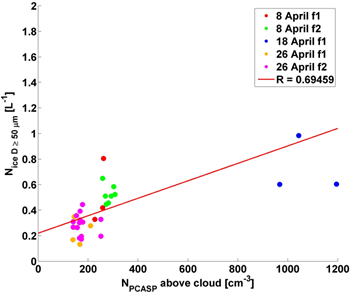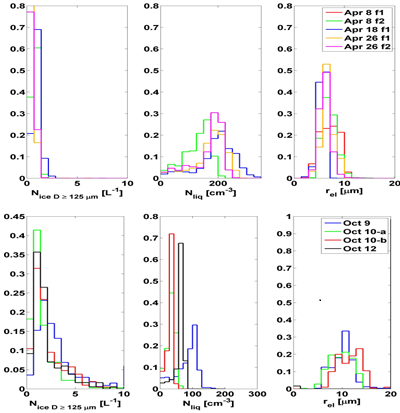How Aerosols Affect Cloud Properties in Arctic Mixed-Phase Stratocumulus
Submitter:
McFarquhar, Greg — University of Oklahoma
Area of research:
Cloud-Aerosol-Precipitation Interactions
Journal Reference:
Science
Clouds play a critical role in determining the radiation budget of the Arctic through their role in complex feedbacks involving the sea ice, clouds, aerosols, and the atmosphere. Although seasonal variations in the concentration and compositions of aerosols exist in the Arctic, there is no clear understanding of the mechanisms by which aerosols impact cloud and radiative properties because most prior cloud-aerosol interaction studies have concentrated on liquid clouds. This lack of understanding significantly contributes to uncertainty in climate change prediction. In this study, cloud and aerosol data acquired by the National Research Council of Canada (NRC) Convair-580 aircraft in, above, and below single-layer arctic stratocumulus cloud during the Indirect and Semi-Direct Aerosol Campaign (ISDAC) in April 2008 and during the Mixed-Phase Arctic Cloud Experiment (M-PACE) in October 2004 were used to test three aerosol effects on clouds that have been hypothesized to act in mixed-phase clouds: the riming indirect effect, the glaciation indirect effect, and the thermodynamic indirect effect.
Impact
The data showed that liquid droplet concentration inside cloud was well correlated with ambient aerosol concentration below cloud. This, combined with increasing liquid water content with height above cloud base and the nearly constant vertical profile of liquid droplet concentration suggested that liquid drops were nucleated from aerosol at cloud base. No strong evidence of a riming indirect effect was observed. But a strong correlation between ice crystal number concentration and aerosol concentration above cloud top, the subadiabatic profile of liquid water content, and the presence of turbulence induced by the close coupling of updrafts and downdrafts are consistent with aerosols in dry air entrained from above cloud affecting ice crystal concentration through the glaciation indirect effect. When comparing ISDAC and M-PACE data, the lower ice crystal concentrations and effective radius for the more polluted ISDAC cases are consistent with the operation of the thermodynamic indirect effect. However, the larger liquid contents of the M-PACE clouds associated with the presence of open water during the fall may also have affected the observed cloud properties.
Summary
Analysis of ISDAC and M-PACE data has identified time periods where the glaciation indirect effect and thermodynamic indirect effect may be the dominant influence on cloud properties. It is possible that the dominant mechanism by which aerosols affect cloud properties also depends on aerosol, surface, and meteorological conditions. More data in a wider variety of meteorological and surface conditions, with greater variations in aerosol forcing, are required to understand the conditions under which various mechanisms dominate the response of clouds and radiation to aerosols.



